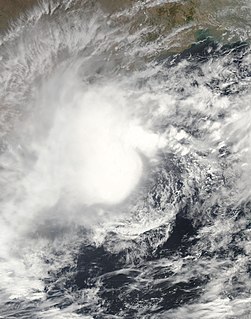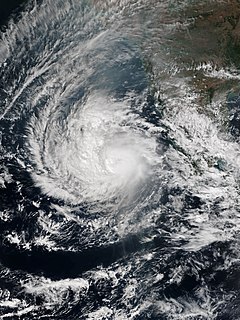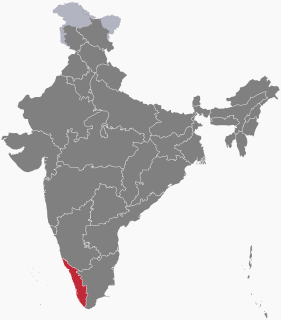
The 1992 North Indian Ocean cyclone season was unofficially the most active year on record for the basin, with 10 tropical storms developing, according to the Joint Typhoon Warning Center (JTWC). There are two main seas in the North Indian Ocean – the Bay of Bengal to the east of the Indian subcontinent – and the Arabian Sea to the west of India. The official Regional Specialized Meteorological Centre in this basin is the India Meteorological Department (IMD), while the JTWC releases unofficial advisories. An average of four to six storms form in the North Indian Ocean every season with peaks in May and November. Cyclones occurring between the meridians 45°E and 100°E are included in the season by the IMD.

The 2003 North Indian Ocean cyclone season was the last season that tropical cyclones were not publicly labeled by India Meteorological Department (IMD). Also was mostly focused in the Bay of Bengal, where six of the seven depressions developed. The remaining system was a tropical cyclone that developed in the Arabian Sea in November, which was also the only system that did not affect land. There were three cyclonic storms, which was below the average of 4–6. Only one storm formed before the start of the monsoon season in June, although it was also the most notable. On May 10, a depression formed in the central Bay of Bengal, and within a few days became a very severe cyclonic storm. After it stalled, it drew moisture from the southwest to produce severe flooding across Sri Lanka, killing 254 people and becoming the worst floods there since 1947. Damage on the island totaled $135 million (2003 USD). The storm eventually made landfall in Myanmar on May 19. It is possible that the storm contributed to a deadly heat wave in India due to shifting air currents.
The 2012 Luzon southwest monsoon floods, was an eight-day period of torrential rain and thunderstorms in Luzon in the Philippines from August 1 to August 8, 2012. Its effects centered on Metro Manila, the surrounding provinces of the Calabarzon region and the provinces of Central Luzon. Not a typhoon in its own right, the storm was a strong movement of the southwest monsoon caused by the pull of Typhoon Saola (Gener) from August 1–3, strengthened by Typhoon Haikui. It caused typhoon-like damage: the most damage caused by rain since September 2009, when Typhoon Ketsana (Ondoy) struck Metro Manila. The heavy rain caused the Marikina River to overflow, destroying areas also affected by Ketsana, triggering a landslide in the Commonwealth area and collapsing the northbound Marcos Highway.

Cyclonic Storm Nilam was the deadliest tropical cyclone to directly affect South India since Cyclone Jal in 2010. Originating from an area of low pressure over the Bay of Bengal on October 28, 2012, the system began as a weak depression 550 km (340 mi) northeast of Trincomalee, Sri Lanka. Over the following few days, the depression gradually intensified into a deep depression, and subsequently a cyclonic storm by October 30. It made landfall near Mahabalipuram on October 31 as a strong cyclonic storm with peak winds of 85 km/h (55 mph). In Chennai's Marina Beach, strong winds pushed piles of sand ashore and seawater reached nearly a 100 m (330 ft) inland. Schools and colleges in the city remained closed for more than three days.

Cyclonic Storm Viyaru, operationally known as Cyclonic Storm Mahasen, was a relatively weak tropical cyclone that caused loss of life across six countries in Southern and Southeastern Asia. Originating from an area of low pressure over the southern Bay of Bengal in early May 2013, Viyaru slowly consolidated into a depression on May 10. The depression gained forward momentum and attained gale-force winds on May 11 and was designated as Cyclonic Storm Viyaru, the first named storm of the season. Owing to adverse atmospheric conditions, the depression struggled to maintain organized convection as it moved closer to eastern India. On May 14, the exposed circulation of Viyaru turned northeastward. The following day, conditions again allowed for the storm to intensify. Early on May 16, the cyclone attained its peak intensity with winds of 85 km/h (55 mph) and a barometric pressure of 990 mbar. Shortly thereafter Viyaru made landfall near Chittagong, Bangladesh. On May 17, it moved over the eastern Indian state of Nagaland.

In May 2003, a tropical cyclone officially called Very Severe Cyclonic Storm BOB 01 produced the worst flooding in Sri Lanka in 56 years. The first storm of the 2003 North Indian Ocean cyclone season, it developed over the Bay of Bengal on May 10. Favorable environmental conditions allowed the system to intensify steadily while moving northwestward. The storm reached peak maximum sustained winds of 140 km/h (85 mph) on May 13, making it a very severe cyclonic storm according to the India Meteorological Department (IMD), which is the official Regional Specialized Meteorological Center for the basin. The cyclone drifted north over the central Bay of Bengal, gradually weakening due to heightened wind shear. Turning eastward, the storm deteriorated to a deep depression on May 16 before it curved northeastward and re-intensified into a cyclonic storm. It came ashore in western Myanmar and dissipated over land the following day.
Beginning on 14 December 2014, a series of floods from the northeast monsoon hit Indonesia, West Malaysia, Southern Thailand, and later Sri Lanka in South Asia. More than 100,000 people have been evacuated in Indonesia, 200,000 in Malaysia, and several thousand in Thailand. Floods are also affecting 1,100,000 in Sri Lanka.

Cyclonic Storm Roanu was a relatively weak tropical cyclone that caused severe flooding in Sri Lanka and Bangladesh during May 2016. It is the first tropical cyclone of the annual cyclone season. Roanu originated from a low-pressure area that formed south of Sri Lanka, which gradually drifted north and intensified into a cyclonic storm on 19 May. However, wind shear and land interaction caused it to weaken slightly, before reintensifying as it accelerated towards the coast of Bangladesh.

Beginning on 14 May 2016, a low pressure area over the Bay of Bengal caused torrential rain to fall across Sri Lanka, causing floods and landslides which affected half a million people. As of 25 May 2016 the death toll was 101 with 100 missing.
The 2017 Sri Lanka floods resulted from a heavy southwest monsoon, beginning around 18 to 19 May 2017. Flooding was worsened by the arrival of the precursor system to Cyclone Mora, causing flooding and landslides throughout Sri Lanka during the final week of May 2017. The floods affected 15 districts, killed at least 208 people and left a further 78 people missing. As of 3 June, 698,289 people were affected, while 11,056 houses were partially damaged and another 2,093 houses completely destroyed. According to Al Jazeera, about 600,000 people have been displaced due to the floods.

Very Severe Cyclonic Storm Ockhi was a strong tropical cyclone that devastated parts of Sri Lanka and India in 2017, and was the most intense tropical cyclone in the Arabian Sea since Cyclone Megh in 2015. The ninth depression, and the third and strongest named storm of the 2017 North Indian Ocean cyclone season, Ockhi originated from an area of low pressure that formed over the southwest Bay of Bengal on November 28. The storm organized into a Depression off southeast coast of Sri Lanka on November 29, causing damage to property and life in Sri Lanka while passing by. Due to high atmospheric moisture and warmer oceanic surface temperature between Sri Lanka and Kanyakumari in mainland India, Ockhi intensified into a cyclonic storm on November 30.
2018 Sri Lanka floods and landslides caused from an annual heavy southwest monsoon beginning around 19 May. As of 26 May 2018; the monsoon floods affected in about 19 districts, killed at least 21 people, about 150, 000 people were affected and further left approximately 23 people missing. The death casualties were reported from 22 May onwards in the provinces including South, Northwest, North and East. About 4 people were reported dead due to lightning, 5 people were killed due to floods and lightning, 8 people died due to drowning and further left 4 people dead resulting from fallen trees. The DMC report claimed about 400, 000 people have been displaced to safer locations. About 105 houses were reported to have fully damaged and over 4832 houses have been partially damaged.
In mid-March 2019, monsoonal downpours caused widespread flooding and landslides across South Asia.

On 1 August 2019, first week, due to heavy rainfall in the Monsoon season, severe flood affected the southern Indian State of Karnataka. As a security measure in the prevailing situation of heavy rains, India Meteorological Department issued Red alert to several regions of coastal and malnad regions of Karnataka state.
The 2019 floods and landslides in Sri Lanka were the floods which were caused from heavy torrential rainfalls during September 2019. As of 26 September 2019; the monsoon floods affected in about 13 districts, killing at least 2 persons, injuring 6 people and about 116, 000 people are affected. One casualty was reported in the Galle District and the other one was reported in Kolonnawa, where a teenager drowned in the flood water. About 282 houses were reported to have been damaged mainly in Galle and Matara while 22 houses out of 150 houses were completely destroyed in the two districts.

During the heavy rainfall over the monsoon period from 1 June to 18 August 2020, all 14 districts in Kerala were affected with 104 dead and 40 injured. Five districts in Kerala were flooded on 7 August 2020. Major reported incidents in relation to flooding include a landslide in Idukki district on 6 August, claiming 66 lives and an Air India plane crash that caused the death of 21 people. The 2020 flood in Kerala marked the third year in a row of severe monsoon flooding.

Cyclonic Storm Burevi was a weak tropical cyclone which made landfall in Sri Lanka, becoming the first to do so since a depression in 2014, and brought minimal impact to Southern India in December 2020. The ninth depression and fifth named storm of the 2020 North Indian Ocean cyclone season, Burevi originated from a low-pressure area which formed on November 28. The system gradually became a depression on November 30, with the JTWC issuing a TCFA soon after. The depression then was upgraded into Cyclone Burevi the following day. Burevi slowly intensified reaching its peak intensity on December 2, just before making landfall in Sri Lanka. Burevi then weakened, entering the Gulf of Mannar the next day. Burevi proceeded to dissipate after stalling on December 5.
The 2021 floods and landslides in Sri Lanka are flash floods and mudslides which were caused from heavy torrential rainfalls during May and June 2021. As of 7 June 2021; the monsoon floods affected in about 10 districts, killing at least 17 persons including about 10 because of floods and 4 people because of mudslides. About 245,000 people were affected living in Colombo, Puttalam, Kandy, Kalutara, Kurunegala, Gampaha, Nuwara Eliya, Ratnapura and Galle. More than 800 houses were reported to have been damaged.
The 2021 South India floods are a series of floods associated with Depression BOB 05 and a low pressure system that caused widespread disruption across the Indian states of Tamil Nadu, Andhra Pradesh, and the nearby Sri Lanka. The rainfall started on 1 November in Tamil Nadu. The flooding was caused by extremely heavy downpours from BOB 05, killing at least 41 people across India and Sri Lanka.

From January to October 2022, excessive rainfall and widespread monsoon flooding occurred in the South Asian countries of Afghanistan, Bangladesh, India, Nepal, Pakistan, and Sri Lanka. It has become the region's deadliest floods since 2020, with over 3,700 people dead.












